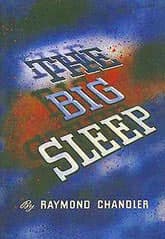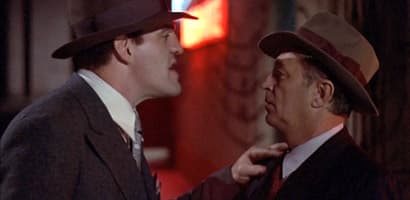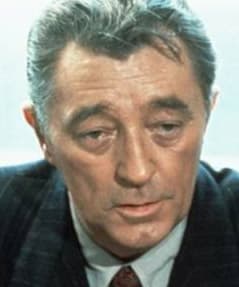The Big Sleep
Critique • Quotes • Philip Marlowe at the movies
 First edition
First editionFirst publication
1939
Literary form
Novel
Genres
Crime, mystery
Writing language
English
Author's country
United States
Length
Approx. 72,000 words

Philip Marlowe takes on a tough client in 1975's retro film noir Farewell, My Lovely.
Good old Marlowe
Farewell, My Lovely (1975): Film, 95 minutes; director Dick Richards; writer David Zelag Goodman; featuring Robert Mitchum, Charlotte Rampling, Jack O'Halloran
The only actor who played Philip Marlowe twice in the movies is Robert Mitchum.
The sleepy-eyed actor had made his name in several notably dark films of the 1940s and 1950s (including the aforementioned Out of the Past), and so it was no surprise that he could take up the role of Chandler's anti-hero so comfortably as he did in 1975 when, in his upper fifties, he starred in a modest remake of Farewell, My Lovely.
This Farewell, My Lovely was an unexpected hit. In the disco-versus-punk era of the mid-1970s it was a nostalgic throwback in style, writing and actors to the cool of 1940s noir.
Mitchum walks through the film as though he's lived in Marlowe's clothes his whole life. Maybe he's a bit old for gumshoe heroics, but that just adds to the comfort level.
Ex-heavyweight boxing contender Jack O'Halloran also walks through his first movie role as the hulking Moose Malloy. His stiffness and slow-speaking menace are perfect for the part of the released convict who wants Marlowe to find his old girlfriend, Velma.
Charlotte Rampling smoulders as the beauty with something to hide.
And watch for Harry Dean Stanton as a cop and Sylvester Stallone in a very small tough-guy role.
Opening shots of Farewell, My Lovely of 1975.
But mostly the film succeeds for its intelligent use of Chandler's text. This is one of the most faithful of all his adaptations. It restores much (but not all) of the grittier material from the book that could not be shown in the 1944 take (called Murder, My Sweet) with William Powell.
Also, its dark and smoky cinematography quite cleverly, even in full colour, takes the viewer back to the morally grey days of earlier film noir.
— Eric


